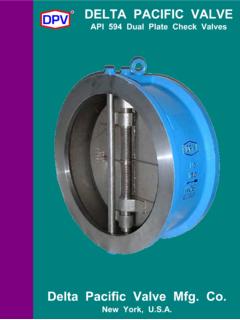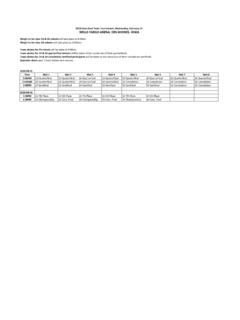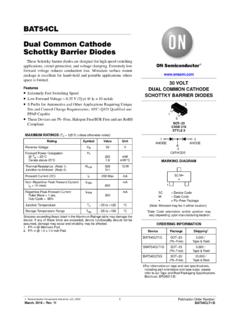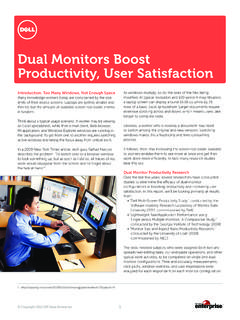Transcription of POSTSECONDARY DUAL ENROLLMENT OPTIONS - …
1 Michigan Department of Education August 2017 POSTSECONDARY ENROLLMENT OPTIONS Frequently Asked Questions Page 1 of 8 This information is provided as a service of the Michigan Department of Education and is distributed with the understanding that the Department of Education is not engaged in rendering legal advice. Those individuals desiring or requiring legal advice should seek the services of an attorney. Individuals should use this as a companion document in conjunction with the relevant statute(s), court case(s), Attorney General opinion(s), and administrative rule(s). POSTSECONDARY dual ENROLLMENT OPTIONS FREQUENTLY ASKED QUESTIONS The POSTSECONDARY ENROLLMENT OPTIONS Act (PA 160 or 1996) provides for payment from a school district s state aid foundation grant for ENROLLMENT of certain eligible high school students in POSTSECONDARY courses of education. The bill establishes eligibility criteria for students, institutions, and courses; requires eligible charges (tuition, mandatory course or material fees, and registration fees) to be billed to a school district; establishes ENROLLMENT and credit requirements; requires school districts to provide counseling and information to eligible students and their parents; and requires intermediate school districts to report to the Department of Education.
2 QUICK REFERENCE The following is not a substitute or replacement of related legislation or rule. Districts should use this document as a companion to the full legislation and administrative rule. Eligibility Eligible Student (1)(f)oA student enrolled in at least one high school class in a school district, public school academy, orstate-approved nonpublic school in foreign exchange pupils enrolled under a cultural exchange program (J-1 Visa).oStudent must have at least one parent or legal guardian that is a resident of Michigan (unless thestudent is experiencing homelessness).oStudent must not have been enrolled in high school for more than four school years (unless oneof the exceptions provided for in administrative rule has been satisfied). Eligible POSTSECONDARY Institution (1)(e)oA state university, community college, or independent nonprofit degree-granting college oruniversity that is located in this state and that chooses to comply with the PostsecondaryEnrollment OPTIONS Act.
3 Eligible Course (1)(d)oCourse offered by an eligible POSTSECONDARY institution for POSTSECONDARY offered by eligible student s high school (or is not available to the student due to anunavoidable scheduling conflict).oAcademic in nature: Normally applies toward satisfaction of [ POSTSECONDARY ] degree requirements. Not ordinarily taken as an activity course. Not a hobby, craft, or recreational a subject area other than physical education, theology, divinity, or religious subject areas assessed on a readiness assessment or the Michigan Merit Examination, eligiblecourses are limited to those subject areas for which the student has achieved a qualifying score. Not required for computer science or foreign language courses. A district may elect to support a student s ENROLLMENT in a subject area that the studenthas not yet achieved a qualifying score if it has been determined to be in the besteducational interest of the limits: Up to 10 courses overall can be covered under the POSTSECONDARY ENROLLMENT OptionsAct.
4 For a student that first dual enrolls in: 9th grade not more than two courses per year in 9th, 10th, and 11th grade, andnot more than four courses in grade 12 10th grade not more than two courses in 10th grade, and not more than fourcourses in 11th and 12th grade 11th or 12th grade not more than six courses per yearMichigan Department of Education August 2017 POSTSECONDARY ENROLLMENT OPTIONS Frequently Asked Questions Page 2 of 8 This information is provided as a service of the Michigan Department of Education and is distributed with the understanding that the Department of Education is not engaged in rendering legal advice. Those individuals desiring or requiring legal advice should seek the services of an attorney. Individuals should use this as a companion document in conjunction with the relevant statute(s), court case(s), Attorney General opinion(s), and administrative rule(s). These limits do not apply when a written agreement exists between a public school district and a POSTSECONDARY institution, or if the district has elected to support a student s ENROLLMENT beyond what is required in PA 160 of 1996.
5 Eligible Charges (1)(c) o Charges covered under the POSTSECONDARY ENROLLMENT OPTIONS Act include: Tuition, mandatory course fees, materials fees (including textbooks required for a course), and registration fees required by the POSTSECONDARY institution for ENROLLMENT in a course. Any late fees charged by a POSTSECONDARY institution as a result of the State or a school district not making the required payment in time (according to this Act). o Transportation fees, parking costs, and activity fees are not eligible charges. o For a district that receives funding through state aid, the district is not required to provide more tuition support under this act than what is received by the district through state aid for the student for the school year. Academic Credit POSTSECONDARY courses may be taken for high school credit, POSTSECONDARY credit, or both. A student makes this decision at time of ENROLLMENT . When more than one course is being taken, a student may make different credit designations for each course.
6 Students attending a state-approved nonpublic school may take courses that are considered essential for POSTSECONDARY credit only. Courses considered nonessential electives may be taken for high school credit, POSTSECONDARY credit, or both. Eligible courses paid for under the POSTSECONDARY ENROLLMENT OPTIONS Act may not be audited by the student. School districts shall grant academic credit and count that credit toward graduation and subject area requirements of the school district when applicable and when a student has designated a dual ENROLLMENT course was taken for high school credit or both high school credit and POSTSECONDARY credit. School districts may determine how much high school credit shall be awarded for a course, and how that credit will be applied to a student s transcript (letter grade, pass/fail, etc.). Sample dual ENROLLMENT Process Process may vary between school districts and nonpublic schools. 1. Student meets with counselor and/or principal to discuss eligibility and other aspects of the POSTSECONDARY ENROLLMENT OPTIONS Act.
7 2. Student receives letter signed by principal indicating eligibility to dual enroll. 3. Student enrolls in eligible course(s) with POSTSECONDARY institution. a. Eligibility letter (2) often used by POSTSECONDARY institution to verify eligibility and payment arrangements. 4. Following drop date of course(s), POSTSECONDARY institution bills school district (State of Michigan billed directly for nonpublic school students). 5. School district (for nonpublic school students State of Michigan) pays eligible charges (up to per course maximum), student responsible for any remainder. Michigan Department of Education August 2017 POSTSECONDARY ENROLLMENT OPTIONS Frequently Asked Questions Page 3 of 8 This information is provided as a service of the Michigan Department of Education and is distributed with the understanding that the Department of Education is not engaged in rendering legal advice. Those individuals desiring or requiring legal advice should seek the services of an attorney.
8 Individuals should use this as a companion document in conjunction with the relevant statute(s), court case(s), Attorney General opinion(s), and administrative rule(s). QUESTION AND ANSWER Overview Questions Q# 1 What are the laws that govern early college credit opportunities for pupils? A# 1 In Michigan, there are two laws that govern early college credit opportunities for pupils. The POSTSECONDARY ENROLLMENT OPTIONS Act (PSEOA) or Public Act 160 of 1996, and the Career and Technical Preparation Act or Public Act 258 of 2000, provide for payment from a school district s state aid foundation grant for ENROLLMENT of eligible high school pupils in POSTSECONDARY courses of education. The law establishes eligibility criteria for pupils, institutions, and courses; requires eligible charges (tuition, mandatory course or material fees, and registrations fees) to be billed to a school. Q# 2 Are districts required to inform pupils of early college credit opportunities? A# 2 Yes.
9 By March 1 of each school year, a school district or state approved nonpublic school is legally required to provide general information about POSTSECONDARY ENROLLMENT opportunities such as Advanced Placement (AP), dual ENROLLMENT , early and middle college high schools, career and technical preparation ENROLLMENT OPTIONS , etc., to all pupils in grade 8 or higher. Districts also are required to send all pupils in grades 9 through 12 who have taken the Michigan Merit Exam (MME) or other state-approved readiness assessment, regardless of score, a letter, signed by the pupil s principal, indicating their eligibility. To assist schools in this effort, the MDE has developed an informational brochure for schools and parents. This brochure is available in two formats and can be found on the MDE high school web site. Q# 3 Must districts comply with this legislation? A# 3 Yes. The law states that districts and public school academies shall use funds allocated under the State School Aid Act to support eligible pupils in their pursuit of ENROLLMENT opportunities in POSTSECONDARY institutions.
10 Thus, districts and public school academies must comply with the pupil s request for POSTSECONDARY ENROLLMENT if the pupil, course, and institution are eligible under this Act. MCL (4)(1) indicates that the school district or state-approved nonpublic school in which an eligible pupil is enrolled shall provide to the eligible pupil a letter signed by the pupil's principal indicating the pupil's eligibility under this act. Q# 4 In what other ways are districts required to support POSTSECONDARY ENROLLMENT under the legislation? A# 4 Counseling is critical. Pupils capable of college-level curricula are not automatically knowledgeable about college course selection and ENROLLMENT process. To the extent possible, districts shall provide counseling services to each eligible pupil and his or her parent or guardian of the benefits, risks, and possible consequences of enrolling in a POSTSECONDARY course. A district may provide the counseling in a group meeting if additional individual counseling is also made available.
















